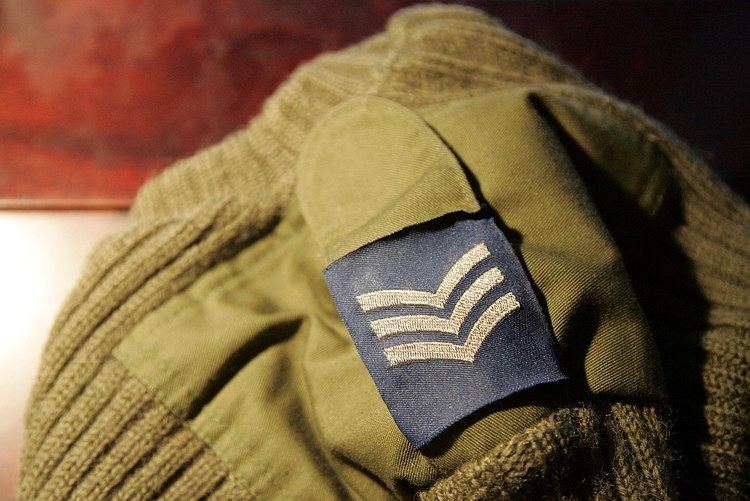 | ||
A shoulder mark, also called an epaulette, shoulder board, rank slide, or slip-on , is a flat cloth sleeve worn on the shoulder strap of a uniform. It may bear rank or other insignia.
Contents
Australia
The newer Auscam uniform design lacks shoulder marks, instead opting for a vertical strap in the middle of the chest region of the uniform. Rank insignia tags are slipped onto this strap. Unlike the older uniform designs, there are slip-ons for every rank in the Australian Defence Force.
The older Auscam uniform designs featured shoulder straps, upon which slip-on rank insignia of Commissioned Officers could be affixed, and non-commissioned officers in the Air Force and Navy only. No shoulder-strap slip-ons are available for enlisted members of the army, whereas the other two services had appropriate slip ons, who have rank patches sewed onto the uniform arms. This older design is no longer issued, but may still be seen on personnel whose most recent uniform issue pre-dates the use of the new design.
Canada
In the Canadian Forces, slip-ons displaying rank insignia and shoulder titles are worn on the shoulder straps of the No. 3 Service Dress shirt, overcoat, raincoat, and sweater; CANEX parka and windbreaker; Naval Combat Dress jacket and shirt; flying suits and flying jackets; and Military Police Operational Patrol Dress shirt and jacket. The slip-ons are worn on a similar-style strap located in the centre of the chest (and sometimes centre of the back as well) of the CADPAT shirt, jacket, parka, and raincoat. Slip-ons are not worn on the Service Dress jacket, or with Mess Dress.
Canadian Forces slip-ons include:
Military
Based on the shoulder boards used by the United States Navy, the United States Army and Air Force developed the shoulder mark, a cloth tube with embroidered or pinned rank insignia. Army officer shoulder marks are black with a 1/8-inch gold stripe below the embroidered grade insignia (the end far from the collar). In the Air Force, a similar stripe is limited to senior officers (majors and above). Air Force general officers have an additional stripe at the near end. Enlisted and Air Force junior officer shoulder marks lack these distinctions. These are worn on all class B uniform shirts. US Navy officers wear shoulder boards on Summer White and Service Dress White uniforms, and wool overcoats and reefers. "Soft shoulder boards" (shoulder marks) are worn on long sleeve white shirts and on black sweaters worn with Service Khaki or Service Dress Blue uniforms. Coast Guard officers wear Naval style shoulderboards on all class B uniform shirts.
Service dress uniforms in the U.S. air and land forces also have a different style of shoulder board, a firm material with an underlying longitudinal strap. The corresponding jacket shoulder has two small loops traversing from rear to front, and the open end of the shoulder board's strap is drawn through the two loops and affixed to the underside of the board. This effectively hides all the means of attachments, leaving a firm, finished surface. This particular style is what U.S. Air Force personnel call a "shoulder board". The shoulder sleeve is called an epaulette, and the two are never confused.
On the United States Army Blue Service Uniform, officers wear embroidered rank insignia "shoulder straps" mounted lengthwise on the outside shoulder seams. These are 1⅝ inches wide by 4 inches/3½ inches (large size/small size) long, and are sewn, snapped, or clipped onto each shoulder.
Boy Scouts of America
The Boy Scouts of America uses colored shoulder loops worn on the shoulder straps to indicate the program level. Webelos Scouts wearing tan uniforms and all Cub Scout leaders wear blue loops, Boy Scouts and leaders wear forest green loops (changed from red in 2008), Varsity Scouts and leaders wear blaze (orange) loops, and Venturers and leaders wear emerald green loops. Adults or youth who hold a district or council position wear silver loops; those with section, area, regional, or national positions wear gold loops, and those with international positions wear purple loops.
United Kingdom
Rank slides are used by all of the UK Armed Forces, primarily on working dress uniforms.
Royal Navy
Shoulder boards are worn by officers on tropical dress uniform, bearing the same insignia carried on the cuffs of the dress uniform. A slide worn on the chest is used to indicate rank for all RN personnel in Action Working Dress (No.4 dress).
Army
In the British Army, shoulder straps are worn with dress and service uniforms. In combat dress, however, rank insignia is displayed on 'rank slides' worn on the chest.
Royal Air Force
In the Royal Air Force, rank slides are worn by all ranks (except Aircraftman, which has no insignia) on the shoulders of working dress uniforms, and also on flying clothing and coveralls. Similar rank slides are also worn on a single tab on the chest of operational (CS95) clothing.
St. John Ambulance
As a ranked organisation, members of St. John Ambulance wear rank slides on all uniforms. Colours are used to differentiate between different health care professionals (e.g., green for paramedics, red for doctors).
